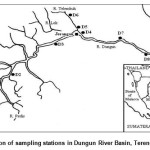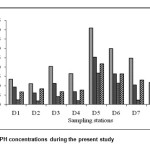Distribution of Total Petrogenic Hydrocarbon in Dungun River Basin, Malaysia
Suhaimi Suratman1,2
1Institute of Oceanography and Environment, 2Environmental Research Group, 2Department of Chemical Sciences, Faculty of Science and Technology, Universiti Malaysia Terengganu, 21030 Kuala Terengganu, Terengganu, Malaysia.
Article Received on :
Article Accepted on :
Article Published : 01 Mar 2013
A study was carried out in the Dungun River basin, southern South China Sea coastal area, during the period of March-July 2003 to determine the distribution of total petrogenic hydrocarbon (TPH). Surface water samples were collected and TPH determined using UVfluorescence spectroscopy. The results showed that the concentration of TPH was in the range of 2.0-40.8 µg/L (mean 12.9 ± 8.8 µg/L). The main source of TPH was probably due to the discharge of effluents from at nearby palm oil factory. Based on the data recorded at other areas, the levels of TPH in the present study were low. These results are useful for consideration in future pollution studies associated with this area.
KEYWORDS:Surface water; total petrogenic hydrocarbon; anthropogenic input; Dungun River basin; southern South China Sea (Malaysia)
Download this article as:| Copy the following to cite this article: Suratman S. Distribution of Total Petrogenic Hydrocarbon in Dungun River Basin, Malaysia. Orient J Chem 2013;29(1). |
| Copy the following to cite this URL: Suratman S. Distribution of Total Petrogenic Hydrocarbon in Dungun River Basin, Malaysia. Available from: http://www.orientjchem.org/?p=11959 |
Introduction
Hydrocarbons are organic compounds derived from natural or anthropogenic sources. According to Lopez and Villaizan1, only small amounts of natural hydrocarbons are present in the environment that has originated from geochemical and biosynthetic cycle. Anthropogenic activities make the largest contribution of hydrocarbons in the environment. Examples of anthropogenic activities resulting in hydrocarbons entering the environment include oil tanker accidents, offshore drilling and tank cleaning2. Total petrogenic hydrocarbons (TPH) is the total hydrocarbon compounds associated with petroleum sources or products. Some TPH such as polycyclic aromatic hydrocarbon can cause carcinogenic and mutagenic effect to the public health3,4. Thus, determination and monitoring of TPH in water bodies is necessary and important for protecting ecosystem and human health.
Dungun River is the longest river in Dungun and flows into the South China Sea near town of Dungun, Terengganu, Malaysia (Fig. 1). Dungun River is formed from many rivers including the Telembuh, Lok, Loh, and Perlis Rivers. Population density is concentrated at the towns of Dungun and Jerangau. This river basin is important as a source of water for irrigation as well for aquaculture, water supply and wastewater dilution. There are no major industrial activities within the basin with exception of a palm oil factory situated near the Jerangau town.
There is no published data concerning the TPH in the Dungun River basin currently available. Thus, the aim of this study was to evaluate the concentrations of TPH, in order to establish the baseline record necessary for any future monitoring programme and also to compare the result in this region with other areas.
Materials and Methods
Sampling was carried out from March until July 2003. Surface water samples were collected at 8 sampling stations within the basin (Fig. 1) using acid-cleaned glass bottles. After collection samples were acidified to pH 2-3 using concentrated sulphuric acid and transported back to the laboratory. The analytical procedure was carried out according to Parson et al.5. Briefly, water samples were extracted three times with dichloromethane. Extracts were combined and dried over anhydrous sodium sulphate. It was then evaporated to dryness in a rotary evaporator and the concentrated sample was re-constituted in n-hexane. Extracts were stored in glass vials and refrigerated (-4oC) until analysis by spectrofluorimetry using 310 nm for excitation and 374 nm for emission wavelengths. A calibration curve was produced with a crude oil standard. Method efficiency in recovering TPH from water samples was carried out in the laboratory using artificial seawater spiked with crude oil. Recoveries from spiked samples were found to be 89+14%. The data were then tested by two-way analysis of variance (ANOVA) at 95% significance level to show differences between sampling stations and dates of sampling.
 |
Figure 1: Location of sampling stations in Dungun River Basin, Terengganu. Click here to View figure |
Results and Discussion
The results for the TPH obtained during the present study are summarized in Fig. 2. The concentrations for the TPH were in the range of 2.0-40.8 µg/L (12.9 + 8.8 µg/L). Statistical tests showed that the TPH concentrations were significantly different (p<0.05) between sampling
 |
Figure 2: TPH concentrations during the present study. Click here to View figure |
stations and dates of sampling. In general, higher concentrations of TPH were clearly observed during first sampling which was carried out during the rainy season. This suggested that rainfall potentially resulted in higher TPH due to terrestrial runoff into the river. As reported by others, storm water runoff from land area is a major source of addition pollutants to the river system, thus increasing their concentration in this system6,7.
In this present study, higher concentrations of TPH were recorded at stations D5 and D6. The possible source of TPH in these stations was due to the presence of a palm oil factory in West Felda Jerangau. Discharge of palm oil waste into the river systems was observed during the sampling periods. No studies have been carried out to date on the relationship between palm oil wastes and TPH concentration, as it was always associated with petroleum sources or products8-12. In addition, stations D7 and D8 which were located downstream of Dungun River basin, showed higher concentrations of TPH compared to the upstream stations (D1 to D4). The Dungun River flows through villages, farms and past a palm oil factory. It also passes through the populated urban areas of Dungun and Jerangau and receives and carries different kinds of agricultural and urban solid and liquid wastes produced by agricultural based industries and domestic sewage. This could be a result of continuous deposition of hydrocarbons derived from different pollutant sources (petrogenic and/or biogenic). Besides that, activities such as sand digging at station D8 may introduce some TPH into the river as a result of the discharge of oil from the machinery used for excavation.
The levels of TPH in this study area shown to be lower than those reported in other Malaysian aquatic environments. Abdullah et al. recorded the range of concentration from 5-386 µg/L at Malaysian west coast of coastal waters8. Much higher concentrations of TPH were found at the Strait of Johor, Peninsular Malaysia which ranged from 25 to 2795 µg/L9. A recent study by Suratman et al. recorded values of 4-121 µg/L at Setiu Wetland, Terengganu10. In addition, the concentrations of TPH were also lower compared to Bohai Bay, China (23.7-508 µg/L)11, northwestern Arabian Gulf (1.2-546.4 µg/L)12 and U.K. marine water (1.1-74 µg/L)13. The higher concentrations found in these previous study areas where due to shipping activities, oil transportation, urban runoff and land-based waste water discharges. Oppenheimer14 has suggested that if the level of TPH in the water exceeded 100 µg/L sould be considered to be polluted. Thus, our results indicate that the TPH concentrations in Dungun River basin have not yet reached concentrations that could be considered as ‘polluted’.
In conclusion, the concentrations of TPH in Dungun River basin ranged from 12.0-40.8 µg/L (12.9 + 8.8 µg/L). Generally, the highest concentrations of TPH were observed at the stations situated at the middle of the basin and were probably due to the discharge of effluents from a palm oil factory. Some anthropogenic activities were also likely to have contributed enhanced TPH concentrations at the downstream stations of the basin. It can also be concluded that the levels of TPH in the study area were generally lower than other selected study area. We suggest further monitoring of this parameter should be carried in order to allow effective pollution control assessment in the future.
Acknowledgement
The author appreciated the Department of Chemical Sciences, Universiti Malaysia Terengganu for the financial support of this project. The assistance of Ms. Yean Lai Yee in the sampling and analysis is kindly acknowledged. Thanks to Dr. Keith Weston (Cefas, U.K.) for assistance with the proof reading of the manuscript.
References
- Lopez, M. and Villaizan, A., Polycyclic aromatic hydrocarbons. In: Nollet, L.M.L (ed.). Handbook of water analysis. Marcel Dekker Inc., United States (2000).
- Cheung, C.C.C., Zheng, G.J., Li, A.M.Y., Richardson, B.J. and Lam, P.K.S., Relationships between tissues concentration of PAHs and antioxidative responses of marine mussels, Perna Viridis. Aquat. Toxicol. 52: 189-203 (2001).
- Stout, S. A., Uhler, A. D. and Emsbo-Mattingly, S. D., Comparative evaluation of background anthropogenic hydrocarbons in surficial sediments from nine urban waterways. Envin. Sci. Technol. 38: 2987-2994 (2004).
- Guo, W., He, M., Yang, Z., Lin, C. and Quan, X., Aliphatic and polycyclic aromatic hydrocarbons in the Xihe River, an urban river in China’s Shenyang city: Distribution and risk assessment. J. Hazard. Mater. 186: 1193-1199 (2011).
- Parsons, T. R., Maita, Y. and Lalli, C. M.. A manual of chemical and biological methods for seawater analysis. Pergamon Press, Oxford, 173pp (1984).
- Suratman, S., Che Zan, N.H. and Mohd Tahir, N., A dissolved and particulate Zn in the Terengganu River estuary, southern South China Sea (Malaysia). J. Sustain. Sci. Manage. 7: 124-127 (2012).
- Suratman, S., Hang, H.C., Shazili, N.A.M. and Mohd Tahir, N., A preliminary study of the distribution of selected trace metals in the Best River basin, Terengganu, Malaysia. Bull. Environ. Contam. Toxicol. 82:16–19 (2009).
- Abdullah, A.R., Tahir, N.M. and Wei, L.K., Hydrocarbons in seawater and sediment from the west coast of Peninsular Malaysia. Bull. Environ. Contam. Toxicol. 53: 618–626 (1994).
- Abdullah, A.R., Woon, W.C. and Bakar, R.A., Distribution of oil and grease and petroleum hydrocarbons in the straits of Johor, Peninsular Malaysia. Bull. Environ. Contam. Toxicol. 57: 155–162 (1996).
- Suratman, S., Mohd Tahir, N. and Latif, M.T., A preliminary study of total petrogenic hydrocarbon distribution in Setiu Wetland, southern South China Sea (Malaysia). Bull. Environ. Contam. Toxicol. 88:755–758 (2012).
- Li, Y., Zhao, Y., Peng, S., Zhou, Q. and Ma, L.Q., Temporal and spatial trends of total petroleum hydrocarbons in the seawater of Bohai Bay, China from 1996 to 2005. Mar. Pollut. Bull. 60: 238-243 (2010).
- El Samra, M.I., Emara, H.I. and Shunbo, F., Dissolved petroleum hydrocarbon in the Northwestern Arabian Gulf. Mar. Pollut. Bull. 17: 65-68 (1986).
- Law, R.J., Hydrocarbon concentrations in water and sediments from UK marine waters, determined by fluorescence spectroscopy. Mar. Pollut. Bull. 12: 153-157 (1981).
- Oppenheiner, C.H., Oil ecology. In: Geyer, R. A. (ed.). Marine environment pollution I. Hydrocarbons. Netherlands: Elsevier Scientific (1980).

This work is licensed under a Creative Commons Attribution 4.0 International License.









